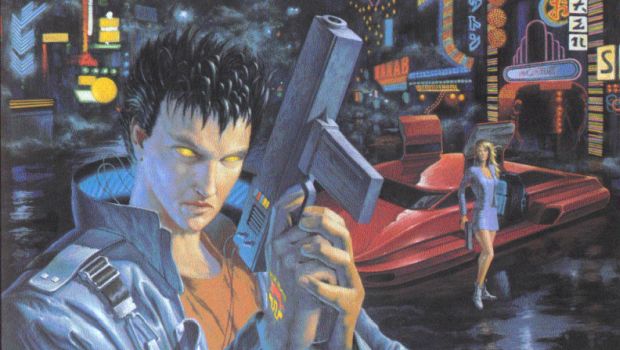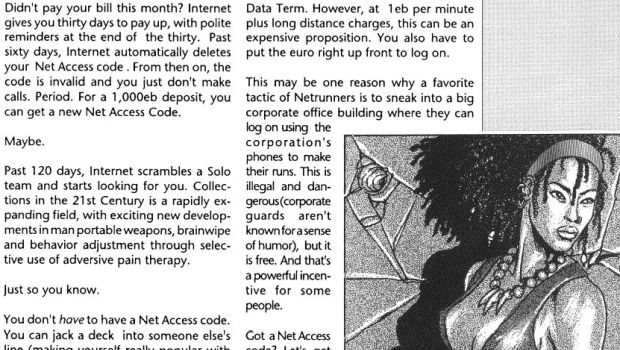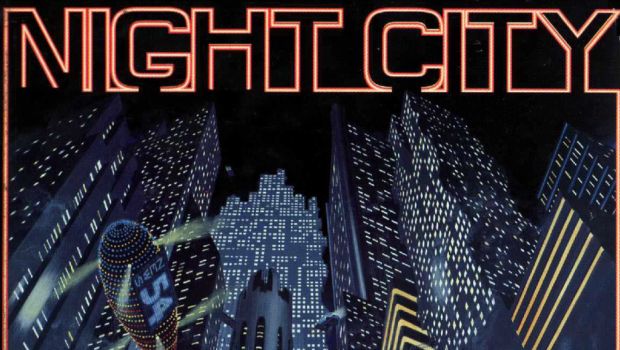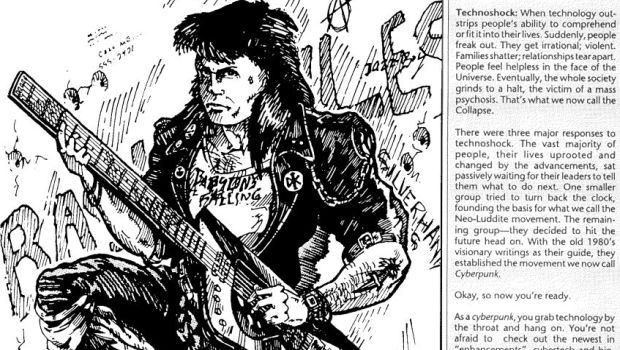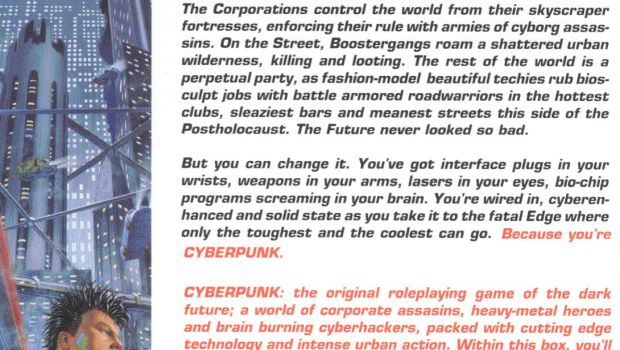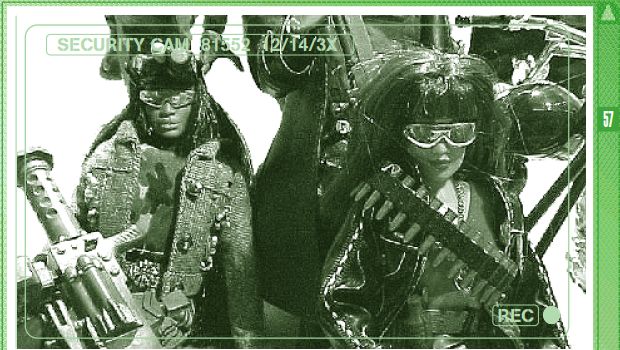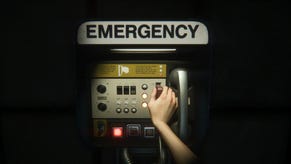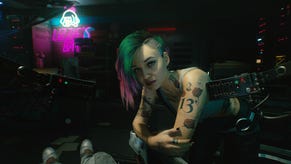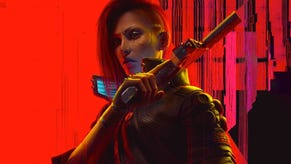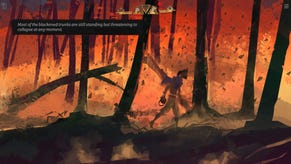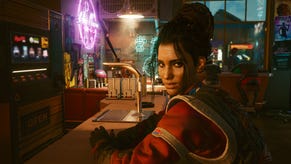What the Cyberpunk 2020 RPG can tell us about Cyberpunk 2077
What would Saint William Gibson do?
The raw material for CD Projekt's next video game, Cyberpunk 2077 [official site] – and no, I don't know its release date either – is a pen-and-paper RPG called Cyberpunk 2020. The game's moving the timeline forward because reality is catching up and 2020 seems worryingly close. The tabletop RPG has done something similar – its original rules were published in 1988 and set in 2013, the second edition jumped forwards seven years, and there was a third edition set in the 2030s nobody talks about. (Just as long-running TV shows have a season fans disown, RPGs have their verboten edition.)
Cyberpunk 2077 is wisely going back to 2020 for inspiration. The most popular edition, it was detailed in a 250-page rulebook, over 30 supplements, two novels, and a card game. That's a lot of source material, a solid base for launching wild speculations about the video game from. So let's do that - while discussing what made Cyberpunk 2020 interesting in the first place.
Its designers, foremost among them Mike Pondsmith, based their game on first-wave cyberpunk, the original 1980s stories by William Gibson and co. That means mirrorshades and leather jackets, but more importantly a cynical view of how we'll cope with technological advances. Computers get better and our lives get worse, to grossly simplify the themes of an entire genre.
In the Cyberpunk 2020 timeline this technoshock is so extreme it brings on full socio-economic collapse, the future arriving so fast that mass psychosis comes with it. Megacorporations provide a neo-feudal alternative to an incomprehensible social order, but some reject this, embracing their status as disposable chrome outcasts. They look back to the 80s to look forwards, creating a revolutionary movement inspired by cyberpunk fiction.
This isn't like a zombie movie where no one says “zombie”. Its heroes are called cyberpunks, or sometimes Edgerunners, and it's both cringey and wonderful. I hope CD Projekt keep this – it adds humanising lightness to an otherwise dark setting. Characters are aware they're in a world resembling genre fiction. They use “Gibson” as slang for someone who predicts the future, and call the man himself “Saint Willie”.
Cyberpunks are defined by Roles. Techies and Medtechies specialise in repair and surgery, while Nomads are vehicle specialists and road warriors. Rockerboys/Rockergirls are guitar-wielding bards who convince their audiences to start riots. Netrunners are hackers, but saddled with such complex rules hardly anybody played them. Solos are cybered-up soldiers and assassins modeled after samurai (much more popular with players). Medias are truth-telling reporters with cameras bolted to their heads. Fixers are streetwise dealmakers with criminal connections. All those Roles suit an anti-authoritarian game about sticking it to the man, but Cop and Corporate were both playable Roles as well.
Though the text encouraged revolution, there was freedom to play other ways. You could be junior executives at Arasaka hiring cyborg ronin to sabotage rivals, or detectives on the mean streets. A Rockerboy, Rockergirl, or Media could turn everyone else into members of their entourage. Lots of players compromised for a middle-ground of amoral mercenary work, but the potential was there.
An open-world RPG would be perfect for this, with storylines for separate factions, recruitable companions embodying the Roles, and the option to stop freelancing for the local police precinct when you get bored and sign on to join a boostergang instead. In a tabletop RPG freedom makes a lot of work for the poor person running the game. In an open-world video game, it's expected. There will absolutely be a main questline about taking down a corporation, but we'll be able to ignore it if we want.
Characters in Cyberpunk 2020 were defined further by Lifepaths, randomised choose-your-own adventures. They gave characters families, rivals, romantic histories, and backstories as convoluted as any BioWare companion. I don't expect CD Projekt to make a one-to-one adaptation of all the RPG's rules, but Lifepaths were its defining innovation. Since we'll be creating our own characters rather than playing someone with history like Geralt, it would help realise them tremendously.
We also know Cyberpunk 2077 will be set in Night City, in the Free State of Northern California. Night City is divided into a Corporate Zone that's all videoboard skyscrapers, flying cars, and people waving Eurodollars around – the world currency of 2020 – and beyond that Controlled Zones run by crimelords. As a matter of style it's always dark and raining in Night City, a cute excuse for Cyberpunk 2077 to maybe not bother with a day/night cycle.
A nuke was detonated in the centre of Night City in one of the line's final supplements, part of an event called the Fourth Corporate War, which gives CD Projekt some leeway in making the map their own. How much rebuilding happens in the 50 years since we'll have to wait and see, but I expect to see a new Corporate Zone carved out of the city and a radioactive ghetto downtown.
Still, it wouldn't be Night City without old landmarks like Afterlife, a nightclub built in a mortuary, the Totentanz dancehall with its double-digit nightly death count, or biosculpted posergangs (there's one where all 400 members resemble JFK) selling designer drugs called Slam and SynthCoke on the streets.
Outside the city there's a freeway wasteland straight out of Mad Max. Not much cyberpunk fiction deals with the countryside, but Cyberpunk 2020 assumed you'd take the occasional roadtrip. There's likely to be a slice of the country in Cyberpunk 2077, where road raiders ambush corporate convoys and Nomad families evicted from their farms eke out a living.
The other important location is the Net. I mentioned the Netrunning rules were so complicated that hardly anyone bothered with them but a video game can skip that problem entirely. Complex rules can be handled by the computer, and companion NPCs don't sit around running out of snacks while our hero hacks into a Dynalar Technologies data fortress. Given how central it is to the genre, it's a safe bet Netspace will play a part in the video game.
The Net is presented as a blue-white grid with a topography based on connection – places with poor access or corrupted data are mountainous, while good connections make flat plains. Long Distance Links let you jump to far places, otherwise you slog through the Wilderspace between. In Cyberpunk 2077 we might see hacking explore an alternative space with its own geography, rather than abstracted as a minigame.
The other virtual realities in Cyberpunk 2020 are braindances, which are recordings of an individual's experiences that can be relived by others in the comfort of your squalid dystopian apartment. The emotions recorded are felt as vividly as the physical sensations, meaning that while actors can try to fake it the most effective recordings are real. They're SQUID discs from Strange Days, basically.
In a game braindances could be much more immersive than audiologs. As Resident Evil 7 had us play through found footage via videotapes, Cyberpunk 2077 could let us step out of the character we've created to see things from another perspective – although without the audiolog cliché of dying at the end, since if you die in a braindance you die in real life.
Finally, there's Cyberpunk 2020's take on cybernetics: eyes with targeting reticles, brain implants for new skills, skinweave armour, and the whole gamut of artificial limbs and weapons. There's a cost for this beyond the eurobucks, though: the more metal you integrate the less human you become, measured in a loss of Empathy points. Characters with less Empathy are cold fish, slightly robotic, and find it harder to connect with baseline humans. At zero Empathy you suffer cyberpsychosis, with symptoms from compulsive lying and kleptomania to full-blown rampaging murderousness.
Thanks to the CG teaser video released in 2013, which shows the aftermath of a woman's descent into cyberpsychosis and then recruitment into one of the MAX-TAC “psycho squads” who hunt cyberpyschos, Cyberpunk 2077 is obviously going to deal with this. It isn't a sensitive take on mental illness, and it's one I've never been super comfortable with. The idea that robotic legs allowing a cripple to walk also reduce their humanity is galling and the portrayal of mentally ill people as kill-frenzied and ranting about “meatsacks” isn't great either.
Yet its exaggeration makes it impossible to take too seriously, and it does fit with the game's themes. The theme of our reliance on technology alienating us is obviously a pertinent one. It's hard not to see the particulars as owing more to a need to limit players who want to abuse the ability to cyber up than to a desire to explore complicated ideas about humanity, but it could happen.
And exaggeration is a hallmark of Cyberpunk 2020. It's a rock & roll future, even beyond the rockerboys/girls and biosculpted Jim Morrison impersonators. It's rebellious, juvenile, hedonistic, and dressed ridiculously. There are designated Free Fire Zones downtown, gangs of killer clowns and street performers, and one of the competing private ambulance firms is called REO Meatwagon.
Since the word “cyberpunk” isn't one you need to pay for to make another game about neon cops and robbers, there's obviously something about Cyberpunk 2020 specifically CD Projekt want. As much as anything I hope it's this tone, one that's all about attitude and style. If Cyberpunk 2077 doesn't have systems for fashion choices altering how NPCs react to you I'll eat my video jacket.


